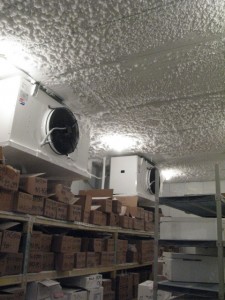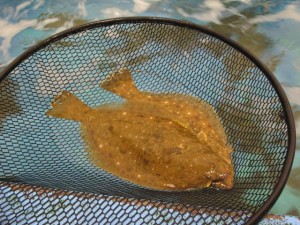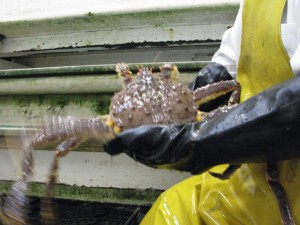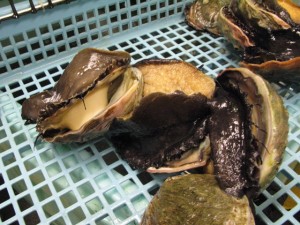Yuji Haraguchi of True World Foods (www.tsukijiexpress.com) offered me and my assistants, Anna and Jennifer, a tour of his NJ company of his company very early one day last week. One of the high points of our tour was the -75 degree F freezer where the flash frozen tuna delivered to the company are kept.

-75 degree F is the most desirable temperature for preserving the quality of tuna. At this temperature the myoglobin is stable and there is no oxidation which turns the fish to a brown color. The fish can be kept as good as fresh for nearly two years at this temperature. (read more in my book The Sushi Experience) While opening the door to the freezer slowly, Yuji warned us to just go in and out without breathing. Breathing at the very low temperature air can damage our lungs, he said. We donned white coats like a doctor, but underneath since it was August were our light summer shirts. After counting just ten seconds, we started to feel deep cold in our bones. According to Yuji if someone were to leave a banana in the freezer it would become like a rock in less than three minutes.
After the freezer visit Yuji took us to the room where they keep fresh, live fish. This is a sushi chef’s and chef’s dream. When the company receives an order for these fish an employee slaughters the fish by the ikejime technique (read more in The Sushi Experience, and sends the fish to the customer in the most fresh and high quality condition possible. Among several species that we saw, live flounder from Korea impressed us. They were flown from Korea on a fourteen hour flight. Most interesting is that the fish are not kept in an oxygenated water tank during transit, but are kept at 45 degree F out of water. We were told that this particular species of fish hibernates at this temperature and can survive even nearly a day out of water before being revived. This was surprising new information for me. Did you know that? At one end of the live fish room we saw delicious looking and amusingly moving abalone. An image of my mother (Tokuko Shimbo) cleaning an abalone – both shell and flesh side – with a hard tawashi brush under cold tap water for a preparation of a summer time delicacy – mizugai – flashed my mind.
After removing the flesh from the shell – not a easy task to do – she meticulously cut the abalone into cubes and served it in cold water chilled with lots of ice cubes along with pieces of crunchy cucumber and very sweet summer tomato. What a simple and refreshing – but back them as well as today very expensive – summer dish!



